
Bromus diandrus is a species of grass known by the common names great brome and "ripgut brome".

Draba albertina is a species of flowering plant in the mustard family known as the Arc dome draba,slender draba or slender whitlow-grass.

Elymus glaucus is a species of grass known as blue wild rye or blue wildrye. This grass is native to North America from Alaska to New York to northern Mexico. It is a common and widespread species of wild rye.

Eragrostis hypnoides is a species of grass known by the common name teal lovegrass. It is native to the Americas from Canada to Argentina. It is found in moist areas near water in substrates of sand or mud.
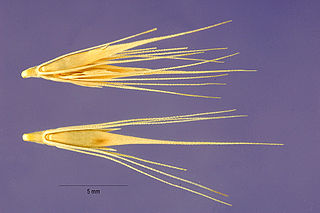
Hordeum depressum is a species of barley known by the common names low barley and dwarf barley. It is native to the western United States from Idaho to California, where it can be found in moist habitats such as vernal pools. This is a small annual grass forming petite patches of thin, hairy leaves and erect stems to half a meter in maximum height. The green or reddish green inflorescence is 2 to 6 centimeters long and about half a centimeter wide. Like other barleys the spikelets come in triplets. There is a large fertile central spikelet about a centimeter long and two smaller, often sterile spikelets on pedicels, each 3 to 5 millimeters long.
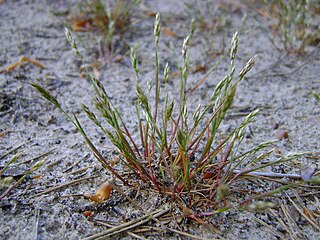
Aira praecox is a species of grass known by several common names, including early hair-grass, yellow hairgrass and spike hairgrass. It is native to Europe, where it is found in dry, sandy places, on rocky outcrops, and in heath grassland. It also grows in North America as an introduced species, where it can be found on the east and west coasts in sandy or rocky areas, such as beaches and roadsides. This is a tuft-forming annual grass growing up to about 10 to 15 centimeters in maximum height. The thin, narrow leaves are located at the base of the stem, and are typically 0.3–2 millimeters wide. It bears small, tightly congested inflorescences of purple-tinted green bisexual spikelets.

Anthoxanthum aristatum is a species of grass known by the common names awned vernalgrass or annual vernalgrass. It is native to North Africa and southern and western Europe as far north as the Netherlands, and it is known in other regions, including northern Europe and North America, as an introduced species. It is occasionally a minor weed of fields. This is an annual grass growing in small tufts up to about 30 centimeters tall. The leaves are short, pointed, and somewhat hairy. The inflorescence is up to 3 centimeters long and one wide, flat and hairy with spikelets a few millimeters long.
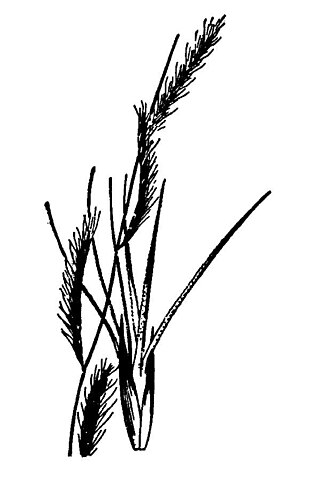
Bouteloua trifida is a species of grass known by the common name red grama. It is native to central and northern Mexico and the Southwestern United States, where it grows in desert scrub and other dry areas.
Agrostis hendersonii is an uncommon species of grass known by the common name Henderson's bent grass. It is native to northern California and Oregon, where it is a rare member of the flora in scattered vernal pool habitats. It is an annual grass ranging in maximum height from 6 to 70 centimeters. It has short, narrow leaves only a few centimeters long. The inflorescence is a dense, narrow, cylindrical tuft no longer than 5 centimeters in length, made up of small spikelets with hairlike tips and bent awns.
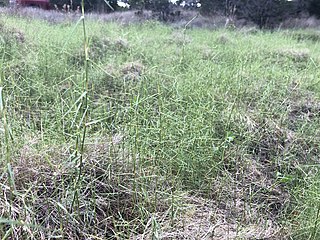
Muhlenbergia utilis is a species of grass known by the common name aparejograss.

Poa bulbosa is a species of grass known by the common names bulbous bluegrass or bulbous meadow-grass. It is native to Eurasia and North Africa, but it is present practically worldwide as an introduced species. It is widespread in the United States and southern Canada. It was introduced to the eastern United States around 1906 and the western US in 1915 as a contaminant in shipments of alfalfa seed. It was intentionally planted on both the east and west coasts to control weeds and prevent erosion. Today it is a common grass across the continent and is a noxious weed in some areas. It is a sturdy, hardy, persistent, aggressive grass that easily outcompetes many other plants and becomes the dominant species in disturbed habitat types, such as overgrazed fields.

Poa glauca is a species of grass known by the common names glaucous bluegrass, glaucous meadow-grass and white bluegrass. It has a circumboreal distribution, occurring throughout the northern regions of the Northern Hemisphere. It is also known from Patagonia. It is a common grass, occurring in Arctic and alpine climates and other areas. It can be found throughout the Canadian Arctic Archipelago in many types of habitat, including disturbed and barren areas.

Puccinellia simplex is a species of grass known by the common names California alkaligrass and western alkali grass. It is native to California, where it grows in mineral springs and other moist habitat with saline soils in the Central Valley, Mojave Desert, and other areas. It is also known from Utah, but occurrences there are probably introduced. This annual grass grows up to about 25 centimeters tall. The inflorescence is generally a linear structure with parallel branches bearing small spikelets.

Setaria verticillata is a species of grass known by the common names hooked bristlegrass, rough bristle-grass and bristly foxtail. It is native to Europe, but it is known on most continents as an introduced species and often a noxious weed. It is a hardy bunchgrass which grows in many types of urban, cultivated, and disturbed habitat. It is a weed of many types of agricultural crops, growing in vineyards and fields. Herbicide-resistant strains have been noted.
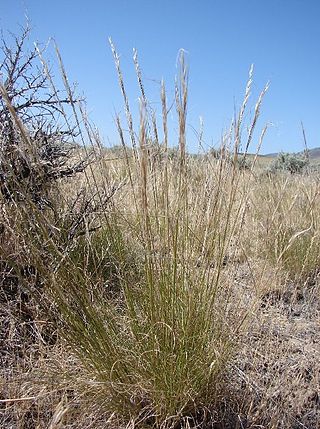
Eriocoma thurberiana is a species of grass known by the common name Thurber's needlegrass. It is native to the western United States, where it occurs from Washington to California and east to Montana and Wyoming.
Festuca ligulata is a species of grass known by the common name Guadalupe fescue. There is one population each in Texas and Coahuila.
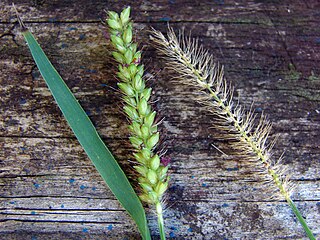
Setaria parviflora is a species of grass known by the common names marsh bristlegrass, knotroot bristle-grass, bristly foxtail and yellow bristlegrass. It is native to North America, including Mexico and the United States from California to the East Coast, Central America and the West Indies, and South America.

Chrysopogon aciculatus is a species of grass native to the tropics of Asia, Polynesia, and Australia at low elevations. Common names include amorseco, lesser spear grass, Mackie's pest, pilipiliula, and grama-amorosa.
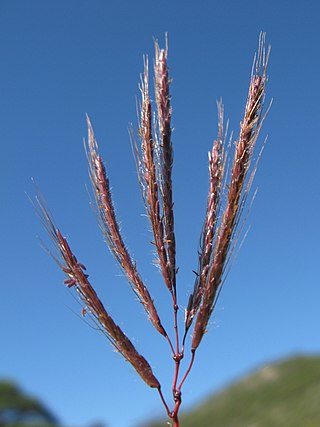
Dichanthium annulatum is a species of grass in the family Poaceae. It is commonly used as a forage for livestock.

Eragrostis pilosa is a species of grass in the family Poaceae. It is native to Eurasia and Africa. It may or may not be native to North America. It is widely introduced, and it is a common weed in many areas.




















